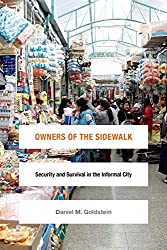
Rating: 8.2/10.
Owners of the Sidewalk: Security and Survival in the Informal City by Daniel M. Goldstein
Book by an anthropology researcher about the informal economy in Bolivia. The informal economy is characterized by the lack of formal employer employee relationships and is a widespread phenomenon throughout Latin America, but especially in Bolivia, where over 80% of the population works in the informal sector. The author spent several years conducting research in La Cancha, the biggest market in the city of Cochabamba. The markets are a constant struggle between the ambulantes (vendors with moving carts), the fijos (vendors with fixed stalls), and the authorities. The ambulantes are the poorest, it is a job that draws many from the countryside who come to the city to look for jobs, only to find that employment is non-existent, so becoming a street vendor is the easiest thing to do to make a little bit of money, since it requires very little skills or capital. The fijos are slightly wealthier, having ownership of a fixed stall in the market, but they must compete with the ambulantes in a crowded marketplace, so the two groups see themselves as rivals.
In the informal sector, authorities still exist, but enforcement is irregular. The line between formal and informal is often blurred: people with “formal” jobs often still don’t pay taxes to the state, give employees protections, etc, and the same people often operate in both. Authorities exist when it is convenient for them (such as when it is time to collect taxes), but disappear when the vendors are in need of protection. The vendors must install basic infrastructure like electricity and sewage systems themselves since the government has failed to do so. The major issue faced by market vendors is insecurity: both in the literal sense (they have to hire private security guards since the police don’t exist), as well as insecurity due to arbitrary enforcement from the authorities. Ambulances often get their wares arbitrarily confiscated, since legally they don’t have the right to exist in the market, and the authorities demand a payment to get their stuff back.
Despite the chaotic situation, there is an informal system that determines who gets what. Vendors operate in syndicates, usually based on the product that is sold: these groups protect each other and try to exclude outsiders from encroaching on their space. Disputes within the marketplace are settled internally, since the police will be unhelpful. Eventually, everybody ends up in a mostly stable state of who is selling what and where. But still, their livelihoods are unstable, they could be robbed or their business confiscated without recourse at any time.
Another part of the book is about the authors experience conducting anthropology in Cochabamba. The author worked with informants (mostly leaders of syndicates in the market), who demanded that they receive something in return for their contributions. Therefore, in addition to publishing academic papers, the author agreed to publish some books and articles in Spanish newspapers to publicize the situation of the ambulantes. This is fair, since without giving back, anthropology would be a unidirectional, extractive affair. After much discussion, they agreed to donate a loudspeaker system to improve security in the market, but the author is realistic about the benefits: the problems are largely structural, so short-term fixes are unlikely to help.
Overall, an insightful book that explains the informal system that permeates most of Latin America: one of the most visible and common themes when I travelled to several different countries in the region. Informality is common in sub-Saharan Africa as well: it is the outcome of market failure and a weak government that fails to enforce property rights and provide basic services, leading to widespread poverty.



